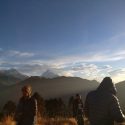More than a year ago, in December 2016, I backpacked through what I consider one of the most accessible trek routes in Nepal – Poon Hill trekking. My friend from college flew in from India specifically for the trek. I am going to write why I choose Poon Hill and why this was my best trek experience? I was psyched. Despite having lived near Pokhara for 22 years, I had never ventured around, and definitely not as far as the Annapurna Conservation Area (ACA). Moreover, trekking which was considered a foreigners’ activity till only a few years ago had been slowly growing among the Nepali youth and I was glad that I was finally partaking in it. So after receiving a trekking permit for my friend from Nepal Tourism Board (NTB) in Kathmandu, off we went on our little adventure not knowing what to anticipate, for it was the first time any of us was trekking for more than a day, 4 days and 3 nights, to be more precise. Continue reading “Why Poon Hill remains my Best Trek Experience?”
Tags: annapurna, Ghorepani Poon Hill Trekking, nepal, Poon Hill, Poon hill trek, Poon Hill Trek Blog, Poon Hill Trekking experience, trekking, Trekking in Ghorepani Poon Hill, Trekking in Nepal Adventure Vision Treks and Travels Pvt. Ltd.


